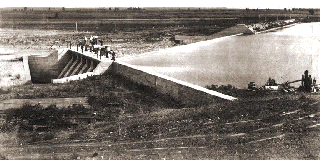- Reclamation
- Missouri Basin and Arkansas-Rio Grande-Texas Gulf
- Multimedia
- Exerpts from the early development of the Belle Fourche Project
Exerpts from the early development of the Belle Fourche Project
The Belle Fourche Project near Belle Fourche, South Dakota, is typical of early Reclamation projects. A method of storing spring snowmelt and storm waters was needed to make farming possible in the semi-arid West. During the late 1800s, local civic leaders saw the need to expand farming in the area primarily to supply the needs of mining communities in the nearby Black Hills and the growing livestock industry. The Chicago and Northwestern Railway reached the town of Belle Fourche in 1891 and for the remainder of the century the town was considered to be the largest original shipping point for livestock in the United States. With the railroad came the opportunity to provide farm produce to a growing area that included cities throughout the midwest.
The demand for stable irrigation water supplies generated a number of private plans for a system of dams and reservoirs. Floods on a number of local rivers and streams increased public sentiment that the runoff be tamed and put to beneficial use. The federal govenment was petitioned to assume responsibility for the construction of a large-scale project that would irrigate public and private lands and was beyond the means of local citizens to construct. Read the text of 1903 letter to the Secretary of the Interior. The newly created Reclamation Service was given the task of developing the Belle Fourche Project. Read an exerpt from the Reclamation Service letter written in 1903 that recommends construction of the project. Read a description of future project lands from the Reclamation Service feasibility report.
Construction of Reclamation projects required daily innovation by project engineers and contractors. Construction methods and equipment were often changed to overcome unique obstacles each site presented. The challenge of moving the vast quantities of material required for dams and canals meant that these projects were the marvels of civil engineering in the American West and often set world records. The equipment and methods used at Belle Fourche are typical of similar early Reclamtion projects.
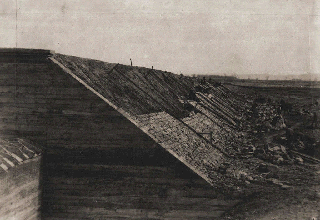
Manual labor was the backbone of early construction. Typical of the labor intensive construction methods was the stone paving used to protect the surface of dams from erosion. Shown here is paving of the embankment on the original Belle Fourche Diversion Dam, 1907. Close examination of the original photo reveals twenty men and one horse at the site. View enlarged photo.
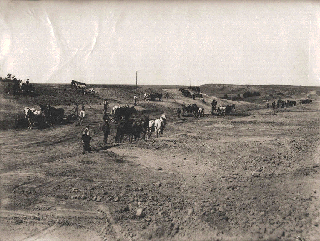
Horse power was common at the construction sites. Teams of horses or mules pulled scrapers, wagons, and fresnos that were seen not only at dam sites but also wherever canals and other water delivery structures were built. Fresnos were a scoop with extended handles that allowed earth to be scraped up, transported, and then dumped as needed by the men handling each team. Numerous teams worked fresnos together along future canals, reservoirs, and roads for the Belle Fourche Project as seen in this 1904 photo. View enlarged photo.
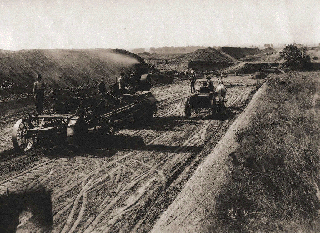
Heavier work was done using steam power. Steam tractors were used when horse power was not sufficient to do the task. The shadow seen in the lower left corner is actually a horse in harness that moved as this 1904 photo taken on the future inlet Canal. View enlarged photo.
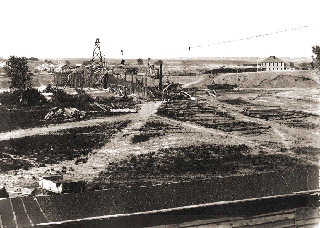
Steam was also used to power cableways, winches, hoists, cranes, pile drivers, concrete mixers and a host of other equipment. Many of these applications can be seen in this 1904 photo at the Belle Fourche Diversion dam. Steel sheet piles are being placed to form a coffer dam to direct the flow of the river around the construction site. Unfortunately spring flooding in 1905 destroyed the coffer dam and delayed completion of the concrete diversion dam. View enlarged photo.
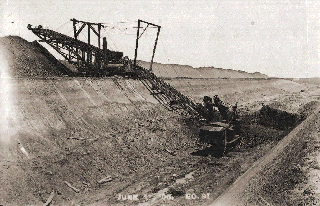
As work was in progress on the diversion dam, earth was being excavated to form the inlet canal that would carry water from the diversion to Belle Fourche Reservoir in another drainage. Several large cuts were required. An Atlantic steam shovel is seen here in 1906 filling derrick cars that were hoisted up and dumped. View enlarged photo.
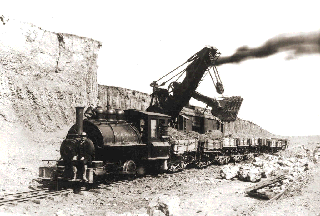
Steam power on a narrow gauge railroad was used to construct Orman Dam (now known as Belle Fouche Dam). Rail cars were filled by steam shovel some distance from the dam site and then pulled to where they were emptied and the earth spread and compacted. As the dam grew the rails were moved so they remained on top. View enlarged photo.
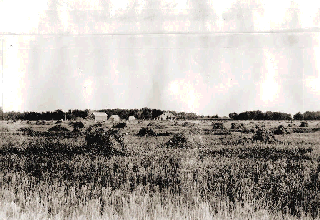
Irrigation water was delivered to some farms even before the project was completed. This 1915 photo shows a typical harvest scene for small grains. The field has been cut and put in small stacks to dry before being threshed to separate the grain. Note the farmstead in the background. View enlarged photo.
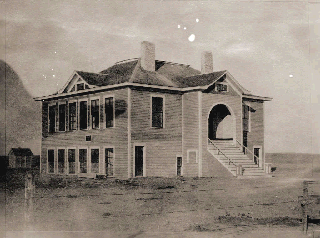
One of the results of the completed project is shown here. This 1915 photo is of the centralized rural school that served the early residents of the project. The school was made possible by the addition of new farmers and the assurance of a stable farm economy to fund it. View enlarged photo.

